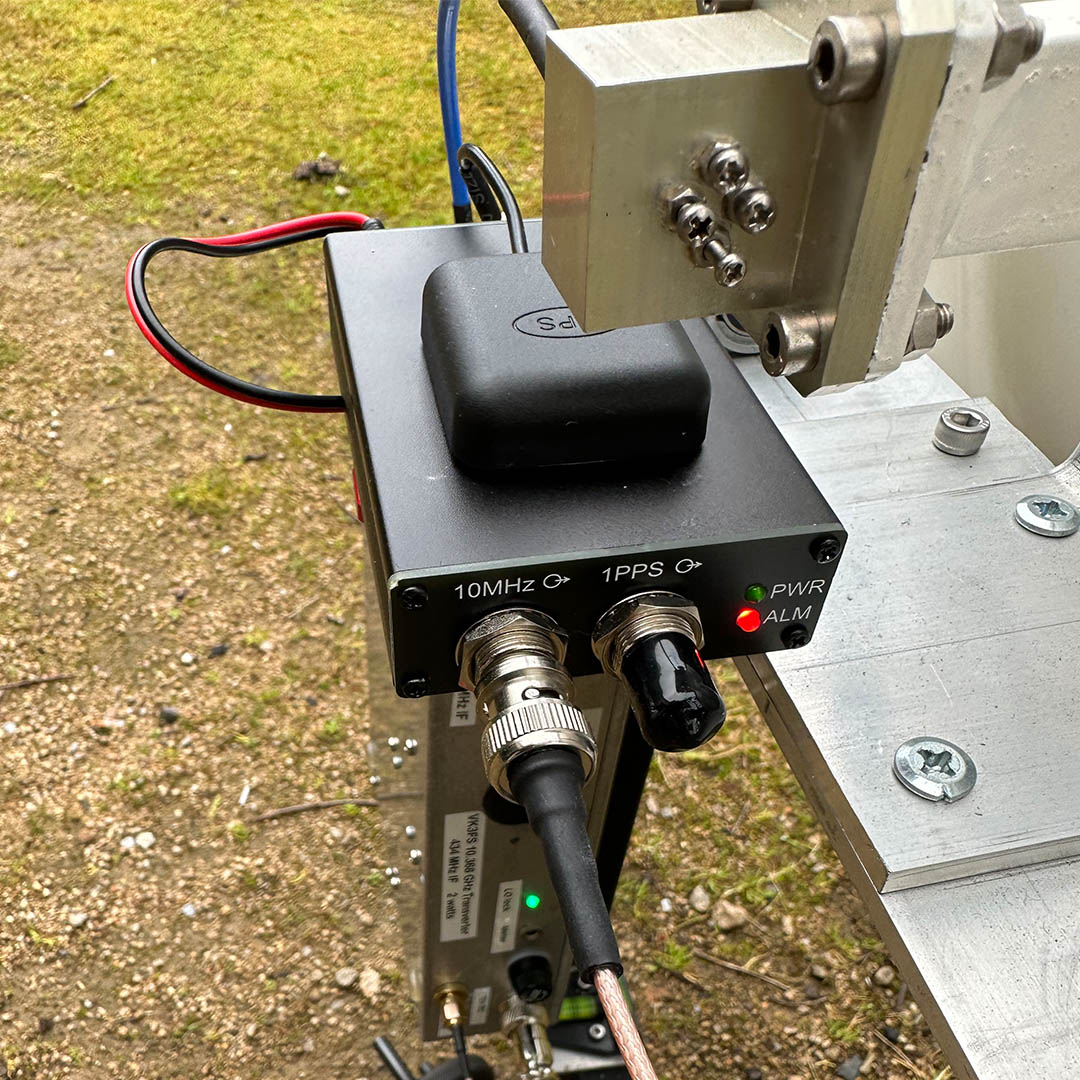
06 Aug External Frequency Reference for Microwave applications
Last Updated on January 18, 2024
Stable 10 Mhz external frequency reference for microwave applications
The new kid is on the block, I’m referring to the new IC-905, prompted me to externally lock my Kuhne 5.7 GHz and 10 GHz transverters. The built-in local oscillator in these Kuhne devices claims stability of 0.5 ppm, that’s half a part per million. But what does that mean? Parts per million (or parts per billion) indicates how much a frequency may deviate from the nominal value.
In a recent presentation, I spoke about the stability of the Kuhne transverters Vs that of the IC-905. Out of the box, the 905 has a built-in GPS receiver used for frequency stability. As you can see by the slide, the frequency variation for a local oscillator with 0.5 ppm stability is 5 Hz. In comparison the 905 claims 65 ppb which equates to variations of around 0.65 Hz.
Apart from aiding in frequency stability, another benefit of externally locking a transverter is improving the usability of Q65 digital signals. Q65 is designed for “making reliable QSOs under weak-signal conditions” according to the WSJT-X user guide.
Frequency stability represents the variation of the output frequency of an oscillator due to external conditions like temperature variation, voltage variation, output load variation, and frequency aging. Frequency stability is typically expressed in parts per million (ppm) or parts per billion (ppb) which can be represented in the form of frequency (usually in Hz).
GPSDO, TCXO or OCXO?
A temperature controlled crystal oscillator (TCXO) or an oven controlled crystal oscillator (OCXO) will drift over time. They are designed to protect the quartz crystal from external temperature changes. External temperature changes can cause the quartz crystal to drift off its desired center frequency. Adjustments are required to keep them on frequency.
High power consumption is one of the major disadvantages of OCXOs – especially when starting cold. This disadvantage typically makes OCXOs not a very suitable option for battery applications. OCXOs require a significant warm-up time of a few minutes before reaching it’s specified temperature range after powering on. This is unlike XOs and TCXOs that can instantly reach their specified frequency stability on start-up.
Temperature controlled crystal oscillators (TCXOs) are similar to OCXOs but there are also many differences. The basic building block for a TCXO is a VCXO with approximately ±50 ppm deviation range and a temperature-sensitive network. This network applies a voltage to the varactor diode that corrects the frequency of the VCXO at any temperature within the operating temperature range. Typical temperature stabilities achieved from TCXOs would be from ±0.20 ppm to ±2.0 ppm.
The GPS system is designed to keep an incredibly accurate time and has perfect stability long term. A GPSDO combines the best of both worlds. It uses a base oscillator with good short-term stability (a TCXO) and then uses a GPS to adjust it over time or keep it on frequency. With a GPSDO you have excellent short and long-term stability. The 10MHz output of the GPSDO is used as a transverter reference ensuring it’s always on frequency.
GPSDOs in the Amateur Radio world
Up until the release of the Icom IC-905, the frequency stability of voice communications on the microwave bands was allowed a little bit of drift. After all, the IC-705 introduce a waterfall feature that allowed ops to “see” where others were on the bands. Tuning was then a manual thing!
Those of us who are keen to work over greater distances are drawn to the Q65 mode if voice fails. This digital mode requires frequency stability. GPS signals are accurate to nanoseconds and provide a good reference for frequency stability applications. The stability of your station is only as good as the stability of the LO.
GPS-locked External Frequency Reference for Microwave application is cheap compared to the price of the gear.
I’ve invested in several GPSDOs in recent times from Trimble devices to BG7TBL devices. All have worked well when it comes to locking transverters. A recent test with a 905 user found that with a GPSDO locked 5.7 GHz transverter and an old IC-275A – yes a 20+ year-old radio, my 5760.1 matched his 5760.1 almost to the Hz. When I removed the 10MHz external reference my transverter move 3kHz up the band.
Working stations that use TCXOs or OCXOs can give your RIT a workout. If there are multiple stations on the frequency it can make for interesting times. Try not to move your TX frequency and let the RIT do the work.
Stability of IF radios
Two of the most common IF radios used by microwave operators are the IC-705 and the FT-817 / FT-818 radios. Both of these radios claim stability of less than 0.5 ppm according to their specifications. The frequency stability of the IF radio is naturally important, but the transverter stability more so.
Neither the IC-705 nor the FT817/818 radios have an easy-to-access way to supply an external reference. If you’re using an IC-705, it’s local oscillator can be manually adjusted if you have a GPS locked beacon in range.
Any external frequency reference for microwave operation is a good idea. GPSDOs are a really good option.




